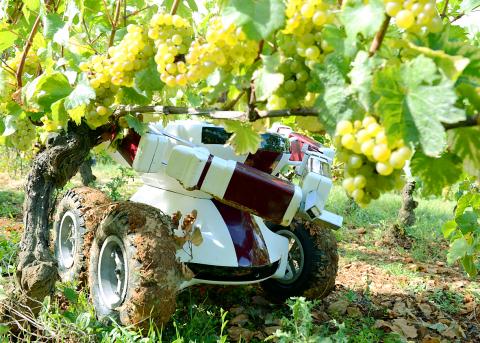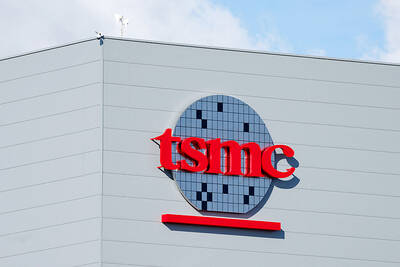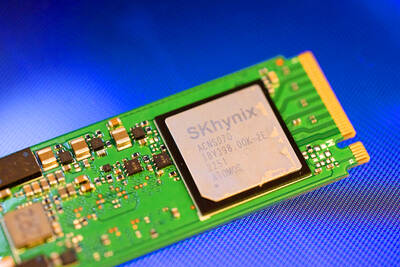A new vineyard worker is looking for a job in France. White with red trim, 50cm tall and 60cm wide, he has four wheels, two arms and six cameras, prunes 600 vines per day and never calls in sick.
The Wall-Ye V.I.N. robot, brainchild of Burgundy-based inventor Christophe Millot, is one of the robots being developed around the world aimed at vineyards struggling to find the labor they need.
It takes on labor-intensive chores likes pruning and de-suckering — removing unproductive young shoots — while collecting valuable data on the health and vigor of the soil, fruit and vine stocks.

Photo: AFP
Sales demonstrations of the 20kg robot are about to begin.
Wall-Ye draws on tracking technology, artificial intelligence and mapping to move from vine to vine, recognize plant features, capture and record data, memorize each vine, synchronize six cameras and guide its arms to wield tools.
An in-built security mechanism is designed to thwart would-be robot snatchers.
“It has a GPS, and if it finds itself in a non-designated vineyard, it won’t start. It also has a gyroscope so it knows if it’s been lifted off the ground,” Millot said.
“If that happens, the hard drive self-destructs and the robot sends a message to the winegrower: ‘Help!’” he said.
Millot’s inspiration came from a frustrated winegrower, Denis Fetzmann, estate manager at Domaine Louis Latour, while on a tour of his vineyards in France’s southeastern Ardeche region.
“He needed to thin the leaves, because the clusters were too big and they didn’t dare use a machine — but they couldn’t find workers. It was August and everyone was on holiday. I told him I’d make him a robot,” Millot said.
It took three years to do so.
“Honestly, it was thousands of hours of work for the two of us — weekends and nights,” said Guy Julien, the toolmaker who partnered Millot to manufacture the robot.
“The biggest challenge was to make the cameras understand what they are seeing and how to interpret it,” Millot said.
Demos using a prototype have already sparked a buzz in winemaker circles.
Excited vintners have rung up Millot with a list of tasks they’d like to delegate.
“Every winegrower asks for different things,” the inventor said. “In Alsace, for example, they wanted de-suckering with a simple knife to clean up the tops of the Gewurztraminer.”
The price tag for the Wall-Ye robot is set at 25,000 euros (US$32,000), the same as a medium-size car.
“Which isn’t bad considering it works day and night, even Sundays, doesn’t take holidays or stop for a snack,” Julien said.
“If I have the choice between the robot and the employee, I’ll take the robot — it’s less expensive and less trouble,” said Patricia Chabrol, owner of Chateau Gerbaud in Saint Emilion, who has seen Wall-Ye at work.
“We have robots in factories, robots that take care of the elderly — I think we can do some very high quality work with this vineyard robot,” she said.
And what of concerns the robot could destroy jobs at a time when French unemployment stands at 3 million?
“Obviously this means we’ll cut the job for vineyard pruners, but we’re creating jobs for someone who has gone to school and who will build, maintain and improve the robots,” Julien said. “And we’re going to keep the manufacturing in France.”
Wall-Ye is one of a handful of similar projects under development in the wine world. Both California and New Zealand are developing intelligent vision-based pruning robots.
Richard Green of the University of Canterbury is developing a pruning robot backed by French drinks giant Pernod Ricard. He predicts it will save the New Zealand wine industry 17.6 million euros per year through increased productivity and reduced yield losses.
“But it’s not just about labor costs, it’s about the quality of the pruning. We often have novice pruners who have to be trained each year,” Green said.
In California, Vision Robotics founder Bret Wallach said their robotic vine pruner, still in test phase, is 3m tall with eight cameras, and pairs a 3D model of the vines with customized pruning rules.
“It’s the same rules you would give a manual crew,” Wallach said.
However, manual crews are growing scarce in California.
“And it gets worse every year,” he said.
Labor issues aside, some French growers are unwilling to see robotic pruners industrialize what has historically been a craft-based product.
“Technically it’s interesting, but intellectually, it’s inconceivable. It doesn’t fit with my philosophy of making a Saint Emilion grand cru,” Chateau du Val d’Or owner Philippe Bardet said.
“I’m all for automating certain tasks, but not pruning,” he said.
Pruning is a particularly sensitive task because it tells the vine how many bunches of grapes to produce and affects its ability to ripen the fruit to perfection.
“Each plant is unique in terms of things like vigor, so it must be treated uniquely during pruning,” Fetzmann said.
“But I can see a robot doing the pre-pruning in November, and humans finishing in March. A machine like this could be really useful stocking data about each individual vine stock, adapting treatments to the diversity in vegetation and soil even within a plot,” he said.

Taiwan Semiconductor Manufacturing Co (TSMC, 台積電) secured a record 70.2 percent share of the global foundry business in the second quarter, up from 67.6 percent the previous quarter, and continued widening its lead over second-placed Samsung Electronics Co, TrendForce Corp (集邦科技) said on Monday. TSMC posted US$30.24 billion in sales in the April-to-June period, up 18.5 percent from the previous quarter, driven by major smartphone customers entering their ramp-up cycle and robust demand for artificial intelligence chips, laptops and PCs, which boosted wafer shipments and average selling prices, TrendForce said in a report. Samsung’s sales also grew in the second quarter, up

On Tuesday, US President Donald Trump weighed in on a pressing national issue: The rebranding of a restaurant chain. Last week, Cracker Barrel, a Tennessee company whose nationwide locations lean heavily on a cozy, old-timey aesthetic — “rocking chairs on the porch, a warm fire in the hearth, peg games on the table” — announced it was updating its logo. Uncle Herschel, the man who once appeared next to the letters with a barrel, was gone. It sparked ire on the right, with Donald Trump Jr leading a charge against the rebranding: “WTF is wrong with Cracker Barrel?!” Later, Trump Sr weighed

HEADWINDS: Upfront investment is unavoidable in the merger, but cost savings would materialize over time, TS Financial Holding Co president Welch Lin said TS Financial Holding Co (台新新光金控) said it would take about two years before the benefits of its merger with Shin Kong Financial Holding Co (新光金控) become evident, as the group prioritizes the consolidation of its major subsidiaries. “The group’s priority is to complete the consolidation of different subsidiaries,” Welch Lin (林維俊), president of the nation’s fourth-largest financial conglomerate by assets, told reporters during its first earnings briefing since the merger took effect on July 24. The asset management units are scheduled to merge in November, followed by life insurance in January next year and securities operations in April, Lin said. Banking integration,

LOOPHOLES: The move is to end a break that was aiding foreign producers without any similar benefit for US manufacturers, the US Department of Commerce said US President Donald Trump’s administration would make it harder for Samsung Electronics Co and SK Hynix Inc to ship critical equipment to their chipmaking operations in China, dealing a potential blow to the companies’ production in the world’s largest semiconductor market. The US Department of Commerce in a notice published on Friday said that it was revoking waivers for Samsung and SK Hynix to use US technologies in their Chinese operations. The companies had been operating in China under regulations that allow them to import chipmaking equipment without applying for a new license each time. The move would revise what is known